Beautiful Austrian actress Hertha Feiler (1916-1970) was the elegant and charming wife of Heinz Rühmann, off-screen and also on-screen in many popular films of the 1940s and 1950s.
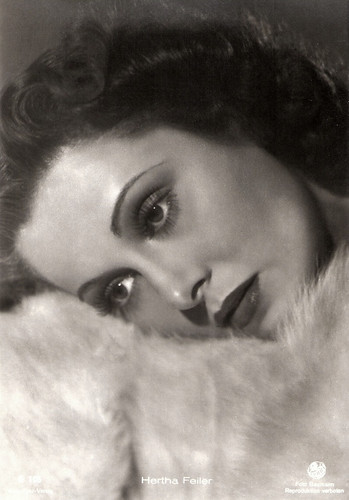
German postcard by Film-Foto-Verlag, no. S 185, 1941-1944. Photo: Baumann / Terra.

German postcard by Film-Foto-Verlag, no. A 3524/1, 1941-1944. Photo: Baumann / Terra.
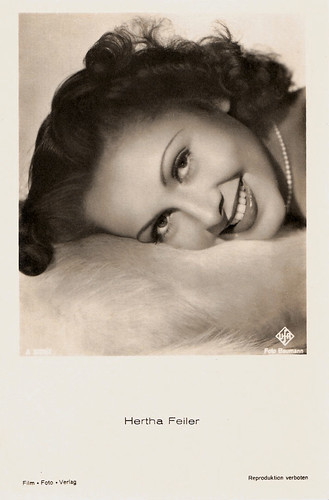
German postcard by Film-Foto-Verlag, no. A 3721/2, 1941-1944. Photo: Baumann / Ufa.
Hertha Feiler was born in Vienna, Austria-Hungary (now Austria) in 1916. Her parents were Josef Anton Feiler and his wife Margarethe née Schwarz. Hertha studied at the Realgymnasium. She originally wanted to become a pianist but tendinitis (an inflammation in her arm) prevented this.
When she looked for another artistic activity, she decided to take acting classes. In 1936 she debuted on stage at the Wiener Scala, and one year later she already made her film debut with Liebling der Matrosen/Favourite of the Sailors (Hans Hinrich, 1937) starring the Austrian Shirley Temple, Traudl Stark.
In the following years, Hertha became a popular actress who knew how to interpret ladylike and cheerful roles with charm. In 1938, when she worked on Heinz Rühmann's debut as a film director, Lauter Lügen/Many Lies (Heinz Rühmann, 1939), they fell in love and married in 1939.
In the next years, they often made films together like Kleider machen Leute/Fine Feathers Make Fine Birds (Helmut Käutner, 1940), Quax in Afrika/Quax in Africa (Helmut Weiss, 1944-1947) and Der Engel mit dem Saitenspiel/Angel with a Harp (Heinz Rühmann, 1944).
Although Hertha Feiler was considered to be ‘one-fourth Jew’ by the Nazi regime and was only able to work with special permission, she and Heinz Rühmann were presented in the press as a model married couple. Their son Peter was born in 1942.

German postcard by Ross Verlag, no. A 2668/2, 1941-1944. Photo: Baumann / Terra.
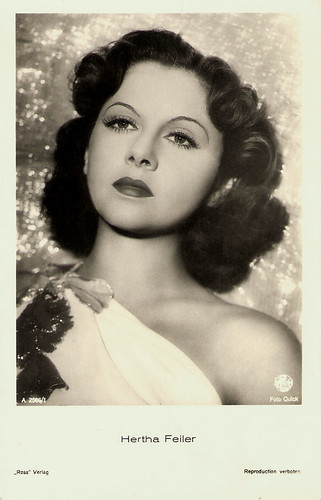
German postcard by Ross Verlag, no. A 2566/1, 1939-1940. Photo: Quick / Terra.
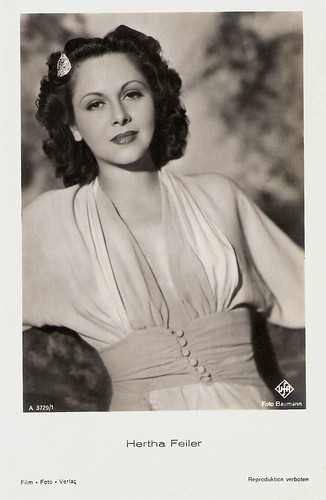
German postcard by Film-Foto-Verlag, no. A 3729/1, 1941-1944. Photo: Baumann / Ufa.
After the end of the war, Hertha Feiler took part in Heinz Rühmann's production company Comedia. After this company went bankrupt, her film career also halted She started to appear more often in stage productions.
In the mid-1950s, more mature film roles followed in which she often impersonated self-confident and cheerful women who also knew the darker side of life. Among her well-known films of that decade belongs Pünktchen und Anton/Punktchen and Anton (Thomas Engel, 1953) based on the children’s book by Erich Kästner.
Other popular films were Die schöne Müllerin/The Beautiful Miller (Wolfgang Liebeneiner, 1954), Charley's Tante/Charley’s Aunt (Hans Quest, 1955), Opernball/Opera Ball (Ernst Marischka, 1956) opposite Johannes Heesters, and Der Maulkorb/The Muzzle (Wolfgang Staudte, 1958) with O.E. Hasse.
With Heinz Rühmann she took part in her last and 33rd film Die Ente klingelt um halb acht/The Duck Rings at Half Past Seven (Rolf Thiele, 1968).
She had to retire from the film business because she was ill with cancer. Hertha Feiler died in München (Munich), Germany in 1970.
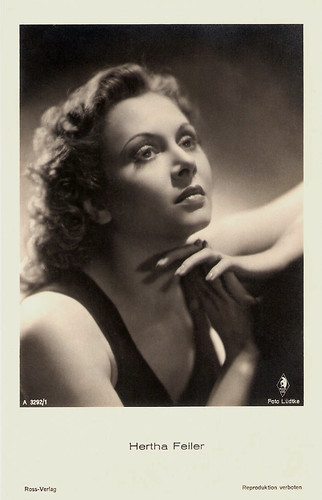
German postcard by Ross Verlag, no. A 3292/1, 1941-1944. Photo: Lüdtke.
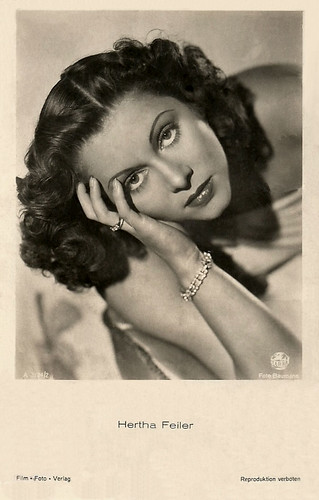
German postcard by Film-Foto-Verlag, no. A 2524/2, 1939-1940. Photo: Baumann / Terra.

German postcard by Ross Verlag, no. A 3401/1, 1941-1944. Photo: Lüdtke / Bavaria Filmkunst.

German postcard by Film-Foto-Verlag, no. A 3835/1, 1941-1944. Photo: Baumann / Ufa.
Sources: Thomas Staedeli (Cyranos), Wikipedia (German), and IMDb.
This post was last updated on 5 March 2024.

German postcard by Film-Foto-Verlag, no. S 185, 1941-1944. Photo: Baumann / Terra.

German postcard by Film-Foto-Verlag, no. A 3524/1, 1941-1944. Photo: Baumann / Terra.

German postcard by Film-Foto-Verlag, no. A 3721/2, 1941-1944. Photo: Baumann / Ufa.
Ladylike and cheerful roles
Hertha Feiler was born in Vienna, Austria-Hungary (now Austria) in 1916. Her parents were Josef Anton Feiler and his wife Margarethe née Schwarz. Hertha studied at the Realgymnasium. She originally wanted to become a pianist but tendinitis (an inflammation in her arm) prevented this.
When she looked for another artistic activity, she decided to take acting classes. In 1936 she debuted on stage at the Wiener Scala, and one year later she already made her film debut with Liebling der Matrosen/Favourite of the Sailors (Hans Hinrich, 1937) starring the Austrian Shirley Temple, Traudl Stark.
In the following years, Hertha became a popular actress who knew how to interpret ladylike and cheerful roles with charm. In 1938, when she worked on Heinz Rühmann's debut as a film director, Lauter Lügen/Many Lies (Heinz Rühmann, 1939), they fell in love and married in 1939.
In the next years, they often made films together like Kleider machen Leute/Fine Feathers Make Fine Birds (Helmut Käutner, 1940), Quax in Afrika/Quax in Africa (Helmut Weiss, 1944-1947) and Der Engel mit dem Saitenspiel/Angel with a Harp (Heinz Rühmann, 1944).
Although Hertha Feiler was considered to be ‘one-fourth Jew’ by the Nazi regime and was only able to work with special permission, she and Heinz Rühmann were presented in the press as a model married couple. Their son Peter was born in 1942.

German postcard by Ross Verlag, no. A 2668/2, 1941-1944. Photo: Baumann / Terra.

German postcard by Ross Verlag, no. A 2566/1, 1939-1940. Photo: Quick / Terra.

German postcard by Film-Foto-Verlag, no. A 3729/1, 1941-1944. Photo: Baumann / Ufa.
Cancer
After the end of the war, Hertha Feiler took part in Heinz Rühmann's production company Comedia. After this company went bankrupt, her film career also halted She started to appear more often in stage productions.
In the mid-1950s, more mature film roles followed in which she often impersonated self-confident and cheerful women who also knew the darker side of life. Among her well-known films of that decade belongs Pünktchen und Anton/Punktchen and Anton (Thomas Engel, 1953) based on the children’s book by Erich Kästner.
Other popular films were Die schöne Müllerin/The Beautiful Miller (Wolfgang Liebeneiner, 1954), Charley's Tante/Charley’s Aunt (Hans Quest, 1955), Opernball/Opera Ball (Ernst Marischka, 1956) opposite Johannes Heesters, and Der Maulkorb/The Muzzle (Wolfgang Staudte, 1958) with O.E. Hasse.
With Heinz Rühmann she took part in her last and 33rd film Die Ente klingelt um halb acht/The Duck Rings at Half Past Seven (Rolf Thiele, 1968).
She had to retire from the film business because she was ill with cancer. Hertha Feiler died in München (Munich), Germany in 1970.

German postcard by Ross Verlag, no. A 3292/1, 1941-1944. Photo: Lüdtke.

German postcard by Film-Foto-Verlag, no. A 2524/2, 1939-1940. Photo: Baumann / Terra.

German postcard by Ross Verlag, no. A 3401/1, 1941-1944. Photo: Lüdtke / Bavaria Filmkunst.

German postcard by Film-Foto-Verlag, no. A 3835/1, 1941-1944. Photo: Baumann / Ufa.
Sources: Thomas Staedeli (Cyranos), Wikipedia (German), and IMDb.
This post was last updated on 5 March 2024.
2 comments:
Such incredibly luminous skin! Or at least killer lighting on th part of the photographer. In any case, she's beautiful.
Great pictures here and what a nice tribute to the stars! Have a great weekend! :) The Bach
Post a Comment